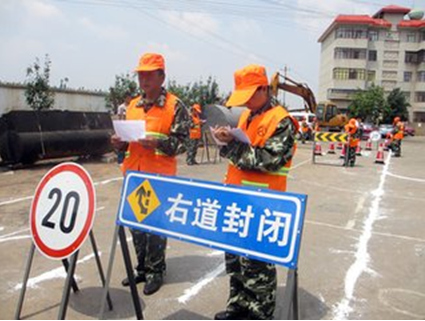It may not be unfamiliar to road maintenance, but the safety measures, safety terminology, and marking symbols commonly used in the specific conservation process may not be very familiar. Xiaobian made a summary of these for everyone.
I. Highway Maintenance Operation Safety Facilities
Traffic signs and markings: Signage markings used for maintenance and repair are classified as proactive safety facilities. Traffic signs and markings should be used in combination.
Isolation Piers and Crash Barrels (Walls): Safety facilities that can be used to channel traffic during maintenance operations include cone-shaped traffic signs, safety belts, road barriers, or construction piers, and crash bins.
Movable sign vehicle: safety protection device with power device or movable device (trailer), generally yellow in color, with yellow construction warning light, and a relatively conspicuous signboard at the back, and its tail should be used during use. Direction of traffic flow, and it is set in the upstream transition zone or the change zone.
Construction warning light: It should comply with the "Road Traffic Signs and Markings" (GB5768-1999) regulations.
Night lighting facilities: When maintenance work is performed at night, lighting facilities should be set up. Lighting facilities must meet operational requirements and cover the entire work area.
Maintenance and Safety Installation and Removal: When performing maintenance and repair operations, safety facilities should be set up along the direction of traffic flow. When the operation is completed, the safety facilities provided for the maintenance work are removed against the flow of traffic and the restoration is made.

Second, safe operating terms
1, maintenance and repair operation control area
The traffic management areas set up for road maintenance and repair operations are divided into six areas: warning, upstream transition, buffer, work, downstream transition and termination.
2. Warning area
The section between the construction sign and the upstream transition zone is set from the starting point of the operation control zone to warn the driver of the vehicle that he has entered the road section for maintenance and repair, and adjusts the driving status according to traffic.
3, the minimum length of warning area
The minimum length of the section of the warning zone required to ensure that the vehicle entering the warning zone decelerates to the speed limit specified in the working zone.
4, the upper transition area
Ensure that the vehicle smoothly transitions laterally from the upstream of the closed lane to the section of the non-closed lane next to the buffer zone.
5, buffer
The section between the upstream transition area and the work area.
6. Work area
Maintenance and repair operations in the construction area.
7, downstream transition area
Ensure that the vehicle smoothly transitions laterally from the lane next to the work area to the normal lane section.
8. Termination area
Located in the downstream of the work area to adjust the road state of the vehicle.
9. Maintenance of safety facilities
Warn, alert, and guide vehicles and pedestrians through conservation and maintenance operations control areas to protect facilities that maintain maintenance personnel and equipment safety.
10. Channelization device
Warn, alert, and guide vehicles and pedestrians through maintenance and repair operations control areas to isolate traffic, flow, and work area facilities.
11. Temporary traffic signs
A temporary traffic sign to meet the safety needs of maintenance and repair operations.
12, temporary pavement marking
Temporary traffic markings to meet the safety requirements of maintenance and repair operations.
Third, the symbol
S—the length of the warning area;
LS-lane closed the length of the upstream transition zone;
LJ - shoulders closed the length of the upstream transition zone;
H - buffer length
G—work area length;
LX - the length of the downstream transition zone;
Z - length of the termination area;
V—vehicle speed;
W—Closed lane width.
Coconut Shell Pyrolysis Plant turns coconut shell into mostly charcoal, some biomass, and little bio-oil, which is totally an environmental friendly project.
The charcoal from it could be widely used for barbecue charcoal, Shisha charcoal or Hookah charcoal etc.
The charcoal pyrolysised directly from pyrolysis plant could last for a long time without any chemicals or adhesive inisde. when used as barbecue charcoal directly, it is quite goodto our human health.
While the boioil could be used as food for animals, which is also quite healthy and nourishing; also could be used as a kind of industry cleanser.
Then the gas generated from system could be used as fuel for pyrolysis plant, which saves lots of outside energy(only required at the first several hours).
At the the end, all the smoking from system could be drawn into dedusting system by Draft Fan, before discharging it is completely environmental.

Coconut Shell Pyrolysis Plant
Coconut Shell Pyrolysis Plant,Coconut Shell Carbonization Plant,Coconut Shell Carbonization Machine,Activated Carbon From Coconut Shell
Henan Lanning Technology Co., Ltd , https://www.lanningrecycling.com
